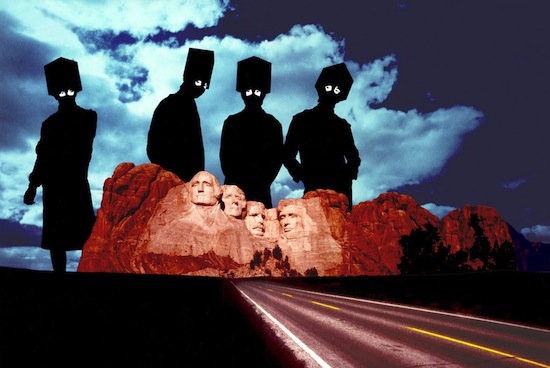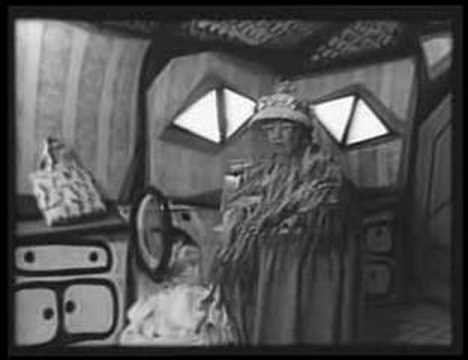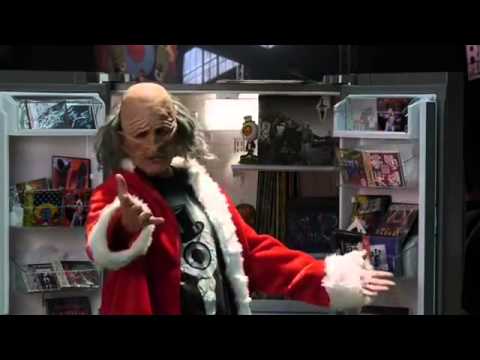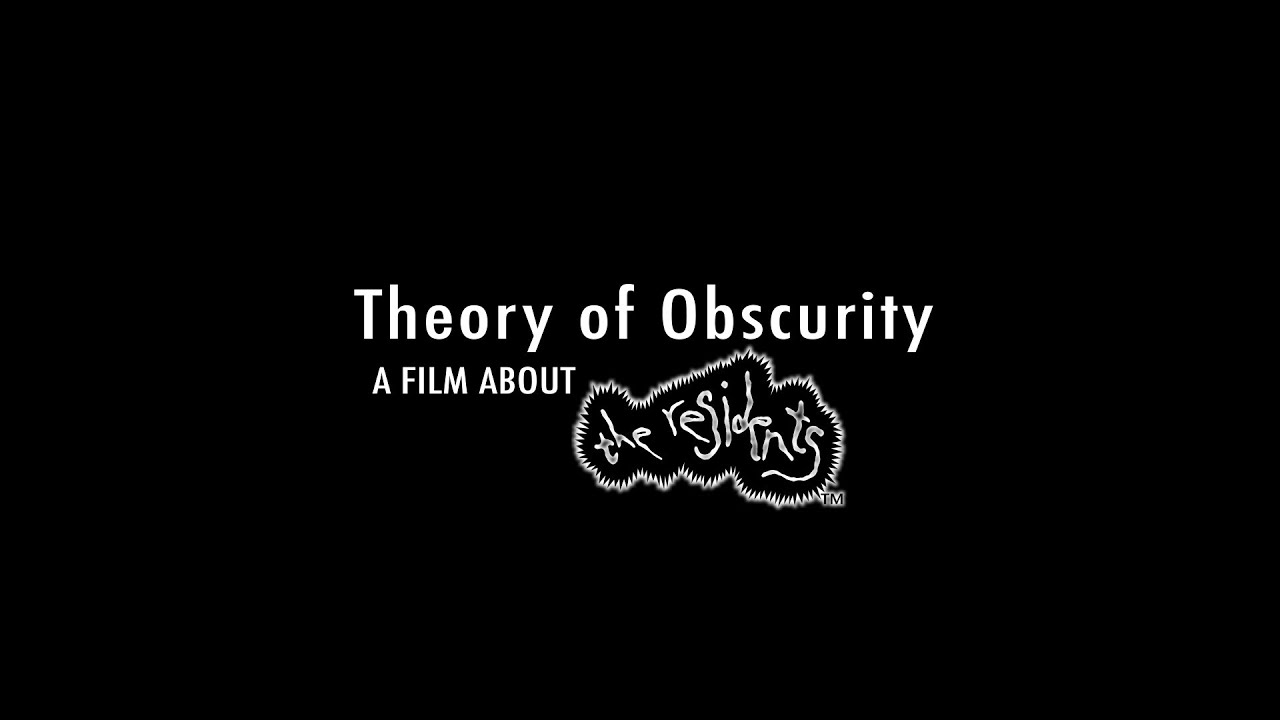Since their first release in 1974, The Residents have released over 60 albums and managed to remain for the most part a mysterious cult interest among fans of the wilder edges of pop, rock and performance art. As the San Francisco-based, anonymous collective embark upon the third instalment in their 40th anniversary celebratory tour, taking in dates in Europe, Australia, Canada and the US, the band’s long-time artist in residence and spokesperson, Homer Flynn, tells us about their evolution from their tape-splicing early days, thwarted experiments in underground filmmaking, their pioneering independent record label, place in the art world and the new documentary The Theory Of Obscurity.
Early Performances
Homer Flynn: The Boarding House performance from 1971 was the first proto-Residents performance. It was at an open mic night more usually frequented by singer-songwriter types with acoustic guitars and long hair, so the audience was pretty much split. There were some people there who were completely bored out of their ass, and they thought this was like a breath of fresh air. Unfortunately they were in the minority. There were a lot of people who just couldn’t wait for The Residents to get the fuck out of there but it was a very lively, very entertaining 20 or 25 minutes.
In between that and the 1976 show with the singer Pamela Zeibak, they didn’t play very many live shows. If you know Residents mythology, one of the legendary figures is the mysterious N. Senada, who accompanied Snakefinger. Again, this was a time when Crosby, Stills and Nash, James Taylor and this kind of thing was very popular. Philip [Snakefinger] was doing auditions at small clubs. Every Monday night would be open mic night, and after accompanying him three or four times, the mysterious N. Senada decided he would try to do his part too. So, when you see the Boarding House, that’s him with the saxophone and the hat and the trench coat, that whole Spy Vs Spy look. He went in as a solo act into these same kind of clubs, half a dozen times – something like that – and so the Boarding House is really an offshoot from those solo performances.
The 1976 show might be seen more as the first Residents performance. All the shows prior to that, we really categorise as pre-Residents. It’s the same kind of attitude and feeling to a great extent, it’s just that the Residents did not exist at that point. Rather Ripped records in Berkeley were having an anniversary celebration at a small club and so they invited the Residents to perform there. Cryptic went in and built the whole stage out of scaffolding and then covered it all with cheesecloth. So you had all these strange little cubbyholes and areas lit in different ways behind the gauze of the cheesecloth. It was very surreal. ‘Six Things To A Cycle’ was among the material played. Arf and Omega, the Siamese twin wrestlers from Vileness Fats, they also performed at that. They did one of the songs from Santa Dog – ‘Aircraft Damage’. It was a mix and there was definitely improv in it but the pieces were pretty much Residents pieces that already existed. Sun Ra was a big inspiration early on, as was Harry Partch and I would say ‘Six Things To A Cycle’ was a direct outgrowth of his influence.
Vileness Fats
HF: When you see the colour stills from VF, there’s a lot detail not captured by the video footage. The Residents were convinced that they were making the underground film of all time and after pouring their hearts, souls, bank accounts and energy into that for three or four years, it started becoming apparent that they would never be able to show this to anybody anywhere, except maybe to a gathering of a few friends. The format was just so low-fi that it really had no life out in the world and that realisation was a big disappointment. That medium really, half-inch reel-to-reel black and white video was considered surveillance video. What was exciting to The Residents was that it was affordable, accessible. If you look at the world now, everyone can do this kind of thing on their phones and do it a hundred times better. The original intention was that the visual part was supposed to be every bit as strong as the musical part. The Residents’ core values came at everything as music fans, so it was really music first but their vision was that the visuals would ultimately stand side-by-side with the music.
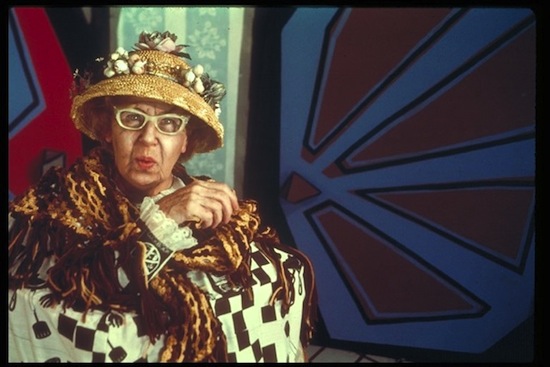
Stage Wear – The Genesis Of The Eyeballs
HF: Originally The Residents wanted a completely different look, a faceless disguise for every new project. For them, their Eskimo album was coming up and they wanted something really special for that and so this idea of a silver globe with the top hat on top and a tuxedo came up
but all of the professional costume makers I talked to in LA said “no, you can’t do that – it’s just going to fog up on the inside, people won’t be able to see, they won’t be able to hear, they won’t be able to breathe.” So I took that information back to the band and during the brainstorming process, somebody said, “Why can’t we make it into an eyeball?” I went back to LA with that, and of course with the eyeball there are similar issues, but at least there’s a little porthole in the front covered with black mesh, so you can see and air can come in, so that was at least a compromise, and ultimately a better idea. After the eyeballs, the Residents kept holding onto the idea of having something different with every new project, but the eyeballs did connect with the audience in a way that nothing else had, so what happened was there was an evolution of that and one of the things that I liked was the cube eyeballs from the Cube E show. At that point, the eyeballs had become full sized suits, worn by dancers, and that was something I found particularly satisfying. As a way of maintaining the continuity of the image but at the same time, breathing new life and energy into it.
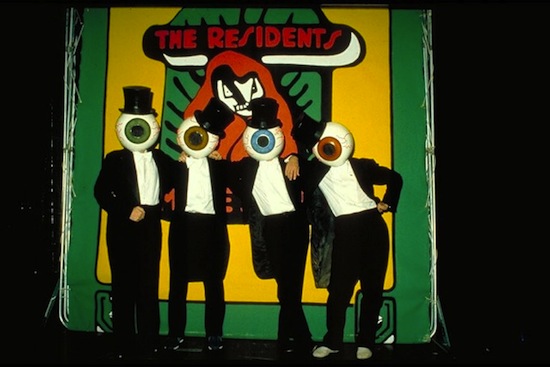
Relationship Of The Residents To The Art World
HF: A copy of The Residents’ Ultimate Box Set (UBS) was donated to the Museum of Modern Art in New York. Barbara London curated several landmark shows at MoMA that were called Looking At Music – 1, 2 and 3, which was the 80s, 90s and 2000s. For the 80s, she included The Residents’ One Minute Movies and the Third Reich ‘n Roll film and for the 90s, she included the Residents Freak Show CD Rom. Barbara and I kind of made friends over the years and when the UBS came about, I proposed to her that the museum buy one. She was a huge supporter and a fan, but she said that there was really no way she could get that kind of money. As the conversation continued, she made it fairly clear that if we wanted to donate one, the Museum would pay for the majority of the expenses. Of course, there was huge sense of satisfaction about it. This thing was assembled in a huge room that they called a sculpture conservatory room, or something like that, where they would take sculptures that were in disrepair. One of the things that was in there was a model that Frank Lloyd Wright had made for an apartment building in Chicago. Somebody had just discovered this thing in a garage, two years before. And there was a gigantic painting by Picasso, that looked like it was something from around his Guernica period, that was also being restored. So, to have the Residents UBS just sitting in the presence of this legendary artwork by legendary artists – it was extremely satisfying.
When it comes to conceptual art, there’s a huge amount that I can look at and, I get it, but it’s not very interesting to me. So much of it seems to be more about writing than it is about something that is compelling from an artistic point of view. And if you don’t take the time to sit and read about what it is that this artist is trying to do, it leaves you completely empty. And even if you do take the time to read it [LAUGHS] it might still leave you somewhat empty. It’s like most of what’s out there. To me there’s no more than five per cent of anything that’s really strong and compelling. The Residents, while there is an art background there, also come from a pop culture point of view, so there’s always been the feeling that there should be some entertainment value in this stuff, besides a strong intellectual backing. The whole idea of mythology and ritual too. Once again, if you go back to Sun Ra, he kind of writes the book on all that. The whole idea about magic as stagecraft, illusion, creating things in the mind of your audience that is so much stronger than reality, which is what magic is all about – all of those things were very influential on The Residents. I saw Sun Ra seven or eight times, at least. If I were to list the five greatest performances of all time that I had witnessed, there would be three Sun Ra shows in there.
Studio Techniques – From The Earliest Recordings To The Present Day
HF: Initially there was a lot of cutting and splicing of tape, and The Residents would make loops. There were times when these loops would be so huge, that it would take three people, one standing at the tape recorder ensuring that it continued to go through, another one standing in one corner and another in another corner, with these loops going around a 30 foot space. That was pretty extreme. A lot of these techniques, that were fairly revolutionary at that time, especially for somebody using them on the fringes of pop music and now that you have a computer, it’s like this was nothing. The other side of this was that, early on, The Residents had a tendency to all be in the studio at one time, which could create chaos but it also created a opportunity for brainstorming too that would cause things to come out that you wouldn’t get otherwise. Whereas, the way things have evolved, is that now, everybody has a laptop, if not a phone, as a recording studio. There’s not nearly as much synchronisation and what has happened is that people have a tendency to create tracks and then send them around and then these tracks either get built upon as they move around, or people just add things and then send them as separate tracks and one person will gather all that together and be the mixmaster machine that creates something out the other side of it.
Multi Media Work: CD-ROM, Comic Book, Commercial Album etc.
HF: We recently did a demo for a VR developer who was interested in potentially licensing Bad Day On The Midway. It didn’t happen, but we needed to get a computer together that could run the old software in order to do that. I have a friend who has an old Mac, and we were able to take that old computer and get Bad Day On The Midway playing. Freak Show, was originally an album and then there was interest from a bunch of British comic artists, Brian Bolland, Savage Pencil and some others, who were Residents fans and were very enthusiastic about creating a comic. Around that same time we connected with the Voyager company who were doing CD-ROMs. So there was music and a lot of the visual material had been created for the comic and then we connected with an artist called Jim Ludtke. He was amazing, one of the most brilliant people that I ever worked with. Artists often have a tendency to break down into two categories, you get people that are very good technically but aren’t really all that creative, and you have people who are wildly creative but who it’s hard to get their stuff to work, because they can’t fit it into the box, technically speaking. Jim Ludtke is one of a handful of people that I’ve ever worked with who was just absolutely brilliant at both. As for the possibility of working on something new in this area, with new technology – The Residents and the Cryptic Corporation are always open to new ideas and new forms but I have to say, that Bad Day On The Midway had a budget of $400,000 in 1993/94, making it far and away the biggest Residents project. It was a beautiful thing and there were a lot of talented people who worked on it and yet, five years later it was obsolete. At least personally, this made me a little wary of cutting edge technology, stuff which may or may not be around very long.
The Residents As Storytellers
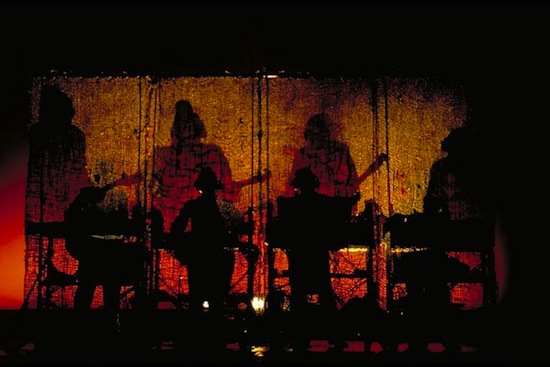
HF: I suppose you could say that in an overt form, The Residents interest in storytelling began with Mark Of The Mole but if you look back, so much of their stuff, even though a lot of the lyrics may seem abstract, you can almost always put together a character or potentially some sort of story behind that. So I guess that the storytelling aspect has always been there, it’s just that it became more refined and more sophisticated and there was more willingness to create more extended narratives. With the newer shows, the storytelling has become very important, with Randy almost taking on the persona of a campfire narrator.
The Current Incarnation – Live shows And Recent Albums
HF: It almost could have ended after The Mark Of The Mole shows. It felt like such a disaster at the time but then about two years later, The Residents were kind of at a down moment, when nothing was going on and that’s when this offer came from Japan. They literally put the 13th Anniversary Show together in six weeks. There’s a record shop there, called Wave – the music marketing end of the Seibu deparment stores. So the Wave Store, which is in a five storey building in Tokyo, in 1985 was having their fifth anniversary and some guy who was a huge Residents fan really wanted them to be a part of the celebration. The fact that they got this offer, and Snakefinger was around and available, meant they just decided to do it. One thing you can say for them, is that though they may have been overly ambitious for the Mole Show but they learned from their mistakes and they made the 13th Anniversary Show as economical as they possibly could and it was successful, which gave the stimulus to do more.
The current show is part III of the trilogy but there’s no intention of that being any kind of an end to things. I mean, life is fragile and you never know what is in store for you but there’s no intention at this point of stopping. We sort of regard the whole Randy, Chuck and Bob trilogy as one big 40th anniversary celebration and in that regard, all the material has been a reworking of material from The Residents’ catalogue. Each show has its own theme, so the material that’s been chosen is material that reinforces those themes. This one has short videos in it – five short monologues done by characters, each talking about their birth, rebirth, reincarnation or near death experiences.
Ralph Records
HF: The Residents have always really liked alliteration, so when it came to having a record company, something with an R seemed like it had a nice sound to it – like Cryptic Corporation. There’s kind of a history and tradition to some extent in America. Sun Records with Johnny Cash and Elvis, that was a small independent label. In a sense though, it was still a time when the gatekeepers controlled 99% of everything and if you didn’t go through the gatekeepers then you didn’t really exist. So for the Residents, there really wasn’t much choice of any other way to get their material out there. At that point the idea existed of expanding Ralph Records. The Residents were so completely out there, that the idea was to create an environment which protected them and allowed them to keep doing what they wanted. So the idea was to release more commercially viable work that would give them the economic cushion. A lot of those groups were local people who seemed like good choices. As that expansion happened, more connections were made, like Fred Frith and Yello. So it expanded in its own organic way really. In terms of the direct relationship that Ralph Records had with the fans, the Buy or Die catalogues and so on, that was relatively new territory. Trying to take stuff straight to the fans, at this point it’s the kind of DIY attitude that everybody does through the internet and so on. It certainly was fairly revolutionary at the time and we were absolutely making it up as we went along. It created a lot of identity and presence for Ralph Records but we never really made very much money.
The Theory Of Obscurity Film
HF: The film was directed by Don Hardy, in collaboration with Barton Bishoff and Josh Keppel. There’s a small theatre in Santa Cruz, just south of San Francisco, where The Residents have been doing their final rehearsals and first performances of tours for years. Josh Keppel was there to cover the Talking Light tour back in 2010, for the local NBC station and he also shot a lot of still photos of the performance. I thought his photos were so good, that I wanted to be able to use some of them for promo, so I got in touch with him and we became friends. Three years later, he and the other two filmmakers were out somewhere having a beer while The Residents were about to go out on The Wonder Of Weird tour. Don Hardy heard the other two guys talking about The Residents and he was looking for a new project at the time. The other two guys got so excited about the 40th anniversary tour that Don, who really wasn’t a Residents fan, got very interested. So he got Josh to set up a meeting and Don and I just clicked right away. He’s a great guy, he has tremendous integrity and he brought a great work ethic and just a great attitude towards the film in general. Two weeks later the tour started and they were out on tour with The Residents and ended up shooting something like 20 performances and everything just kind of spun forward from that.
Personally, I am extremely satisfied with the film. I’ve talked to a lot of people about the end result and some people kind of go, “This is really too much for fans”, and other people go, “This is really not enough for fans”. What that kind of tells me is that it is hitting the right spot. One of the nice things about the film was that it renewed contact with the ex-members of the Cryptic Corporation. Jay Clem, for instance, lives about 60 miles north of San Francisco now, so there’s just not that much reason to see him on a regular basis. But I was the one who put Don Hardy in touch with Jay and John [Kennedy] both and really enjoyed having the reason to see them. They both came to the premiere of the film and both seemed happy to be involved in it. Don Hardy managed to capture and distill a 40-year career into an hour-and-a-half film very well. I would not have wanted that job [LAUGHS]. The Residents come from being influenced by Frank Zappa and Captain Beefheart, who were operating at the fringes of pop music. And then the other side of it is, if you look at the Beatles, who were the essence of pop music, but when you get to things like ‘Revolution No. 9’ or ‘I Am The Walrus’ they got pretty far out on the fringes of pop music too.

